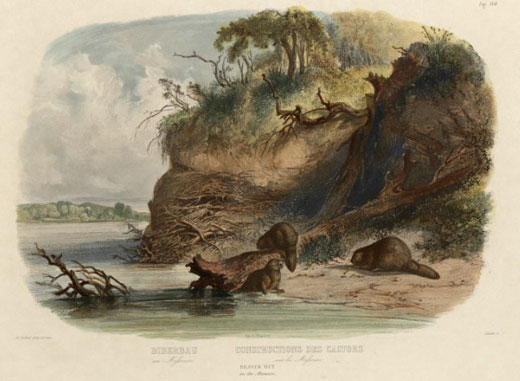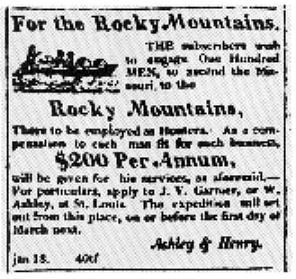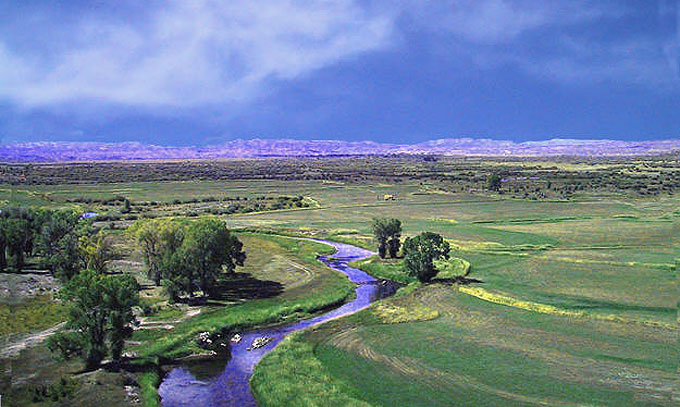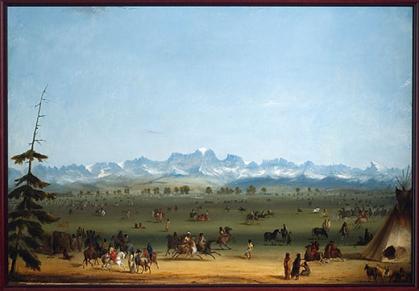- Home
- Encyclopedia
- The Fur Trade In Wyoming
The Fur Trade in Wyoming
The Green, Snake, and Yellowstone rivers, principal tributaries of three of the West’s great river systems, rise in northwestern Wyoming along the Continental Divide. Around the year 1800, this high, well-watered country offered prime habitat for North America’s largest rodent, the beaver. Pelts from this flat-tailed creature were one of the most valuable commodities of a thriving, worldwide fur trade, and the hunt for beaver first brought non-indigenous people into the Rocky Mountains in search of its hide. [1]
Beaver fur makes high quality felt—a commodity in great demand by the hat industry. The fashion of the day demanded that men wear stylish hats, the best of which were made from beaver fur felt. Fashion created a huge market for beaver fur. [2]

Euro-American incursion into what is now Wyoming may have begun as early as the 1740s, when French fur trader Pierre de la Verendrye, is believed to have traveled into the Big Horn Mountains. [3] Francois Antoine Larocque traded furs on Powder River in 1805. [4] But it was after the Lewis and Clark Expedition returned from its epic journey to the Pacific in 1806 and reported the tremendous number of beaver in the mountain West that many adventurers retraced the explorers’ steps in hope of riches.
Lewis and Clark expedition members John Colter and George Drouillard soon returned to the west on their own quest for fur. As employees of the St. Louis-based Manuel Lisa, these two men encouraged Indians to trade at a new post built in 1807 at the confluence of the Bighorn and Yellowstone rivers. [5]
Colter’s explorations have been hashed and rehashed, yet his route remains largely conjectural. He apparently traveled into the area west of present-day Cody along the Stinking Water (today’s Shoshone River) and reported geysers and mudpots. This region came to be called Colter’s Hell, a nickname erroneously given to Yellowstone National Park in later years. Colter also trekked up the Big Horn/Wind River, apparently to its source. [6]
Other Lisa men most likely worked some of the streams in Wyoming, but focused primarily on the waters of the Upper Missouri, moving on to the Three Forks—the headwaters of the Mighty Mo. A contingent of this group, led by Andrew Henry, eventually found themselves on what became known as the Henry’s Fork of the Snake River in present eastern Idaho. On their return east, some of them traversed what is now Wyoming. These were Kentuckians John Hoback, Jacob Reznor and Edward Robinson, three names seen often in early records of the fur trade.
Trappers were soon busy throughout what is now Wyoming. The mixed-race Edward Rose, part black, part white, part Indian, had been active in the Big Horn Basin as early as 1809 and was known to be friendly with the people of the Crow Nation. Not much is known of Rose’s activities in these early years, although he shows up repeatedly in fur trade records. [7] Jacques LaRamee, the fur man after whom the Laramie River would be named, probably trapped in what is now southeastern Wyoming in 1820-21. [8]
As early reports of Rocky Mountain fur riches filtered eastward, millionaire John Jacob Astor put his own plan into effect. In 1810-11, Astor’s Pacific Fur Company sent an overland contingent to the mouth of the Columbia River, led by Wilson Price Hunt. These Astorians were joined by Robinson, Hoback and Reznor, and then crossed present Wyoming on their way west. They traveled up the Bighorn/Wind and crossed the Wind River Mountains via Union Pass, from which elevation they spied the Tetons. The Snake River, flowing past these majestic peaks, served as Hunt’s main guide on his difficult journey to the Columbia. [9]
Meanwhile, Astor sent a second party by sea, among them Robert Stuart. Once the entire company was assembled on the west coast, a fort established and trade opened with the local populations, Stuart was chosen to carry dispatches back to Astor. In 1812, a small, east-bound party again crossed Wyoming. On the way they discovered South Pass, destined to become a transcontinental thoroughfare in the decades to come. [10]
Up until this time, the vast majority of pelts acquired were obtained primarily through trade with American Indians, and Euro-American goods – firearms are a good example -- brought many changes to Indians’ lives. Prior to this point, horses had become key in warfare. The Shoshone, for example, acquired horses earlier than many Rocky Mountain tribes and their power grew as a result. In 1781, however, the Shoshone people were weakened severely by smallpox. Then, around the time of Lewis and Clark, other tribes, particularly the Blackfeet, began to obtain guns from Canadian traders in the British north. Sickness among the Shoshone, and more and better guns among their enemies shifted the balance of power. No longer was the speed and mobility of the horse enough. By the beginning of the 1800s, the once-powerful Shoshone had been driven largely from the plains into the mountains and had lost many of their horses as well. Guns were traded more and more frequently, and with more and more tribes, so that gun powder and ammunition became a major trade item between white and Indian peoples. [11]
A significant change, from trading for furs with Indians to actual trapping by white men in the field was occurring gradually in these years. In the early 1820s, one of Lisa’s earlier partners, Andrew Henry, teamed up with William Ashley to try the fur business. Their Henry/Ashley Company advertised in newspapers for “100 Enterprising Young Men” to head up the Missouri River with them in 1822. [12] For the first few years of these forays into the Rockies the trappers continued to travel up the Missouri River. Travel soon switched to an overland route, however, as the geography became better understood and Indian resistance intensified along the Missouri River. The so-called Arikara War in 1823 made an alternative desirable. [13]
 In the ensuing years, men whose names are still recognizable, such as Jedediah Smith, David Jackson, William and Milton Sublette, Jim Bridger, Thomas Fitzpatrick and many more, found themselves knee-deep in frigid Wyoming streams hunting beaver skins. Many of these personalities left their indelible imprint on the face of Wyoming.
In the ensuing years, men whose names are still recognizable, such as Jedediah Smith, David Jackson, William and Milton Sublette, Jim Bridger, Thomas Fitzpatrick and many more, found themselves knee-deep in frigid Wyoming streams hunting beaver skins. Many of these personalities left their indelible imprint on the face of Wyoming.
A party led by Jedediah Smith learned of South Pass from the Crow during a snowy February in 1824. Smith and his men crossed the pass and soon found themselves on the Green River, which teemed with beaver. Following a successful spring hunt, some of these trappers fashioned a makeshift boat and attempted to float their furs down the Sweetwater River, only to capsize on the North Platte in what’s now known as Fremont Canyon. Digging a cache and secreting the valuable pelts for later retrieval, Thomas Fitzpatrick and the men with him made their way east to Fort Atkinson, near present Omaha, Nebraska. [14]
In 1825, Ashley cached supplies on the Green River in southern Wyoming, near the border of Utah. Instructions to his men indicated this would “be the place of randavoze...on or before the 10th July next.” [15] This would be the first rendezvous of mountaineers in the Rocky Mountains—an event that would occur annually until 1840. Most of these summer trade fairs were held in Wyoming. Six of the last eight meetings were in the Green River Valley west of modern Pinedale. Of the other rendezvous in Wyoming, one was near present-day McKinnon in the southwest corner of Sweetwater County, one near Granger, one near Lander and two near Riverton. [16]
The idea of rendezvous was not entirely new, but Ashley’s use of the concept revolutionized the mountain fur trade. [17] Instead of a forced trip all the way back to St. Louis to sell fur and restock supplies, trappers could visit the rendezvous and take care of both needs. These trade fairs were held in summer months when the passes were accessible to trade caravans, and when trapping was not worth the trouble since the summer hides had relatively little value. For a while, Ashley had a monopoly. He took advantage of it and marked his goods up to what trappers later referred to as “mountain prices.” [18]
Indian tribes came too, including deputations of Nez Perce, Flathead, and Shoshone, and many others in smaller groups. There, they too traded pelts for Euro-American goods such as metal pots, tobacco, beads, blankets, and guns. They quickly developed a dependence on non-native goods. In 1832, John Wyeth stated
We were surprised to find the Indians in the vicinity of the mountains and all around Pierre’s Valley, and the Black-foot tribe, and the Shoshonees, or Snake-tribe, so well provided with muskets, powder and ball, woolen cloth and many other articles, until we were informed that Mr. Mackenzie, an established and wealthy Indian trader, had long supplied them with every article they desired. [19]
Contact with Indians often led to trapper/native marriages—or more military alliances. Such a coalition was particularly useful when less than friendly bands showed up at rendezvous. In 1832, for example, Gros Ventre warriors attacked the incoming supply caravan in the Green River Valley and again at the rendezvous in Pierre’s Hole, today’s Teton Valley, Idaho. Nez Perce and Flathead joined trappers in the ensuing battle. [20]
But Native Americans were not the only ethnic group found in the fur trade. Besides the aboriginal people that lived in what’s now Wyoming, members of Eastern tribes also made their way into the Rockies. Iroquois, Shawnee and Delaware played key roles alongside white trappers. [21] And German, French, Mexican, Scottish, Irish and numerous other populations further diversified the trapper fraternity. The influx of trappers from the Northwest Company and the Hudson’s Bay Company gave a truly international aspect to the trade. As trapper Warren Ferris put it,
One would imagine that where such a multiplicity of tongues are spoken, a confusion, little short of that of Babel would ensue. However, it is not the case. Men who find it difficult to convey their ideas to each other, through ignorance of their opposing dialect, readily make themselves understood by avoiding difficult or abstract expressions, and accompanying their simple speech with explanatory gestures. [22]
After that first rendezvous, Ashley sold out his interest in the fur trading company, using his profits in an unsuccessful run for governor of Missouri. Successor companies began with the partnership of Jedediah Smith, David Jackson and William Sublette, who later sold out to Thomas Fitzpatrick, Jim Bridger, Milton Sublette, Jean Baptiste Gervais and Henry Fraeb. This latter enterprise was the first and only to be called The Rocky Mountain Fur Company.

News spread of the trade’s potential profits. Small, relatively inconsequential firms such as those led by Robert Bean and Alexander Sinclair, Benjamin Bonneville, or Nathanial Wyeth attempted to garner a share in the take. But it was the giant American Fur Company (AFC) that offered the greatest competition. This Astor conglomerate established a series of trading posts, and put men in the field to go toe-to-toe with rival trappers—and pretty much took control of the industry. Even though Astor sold out in 1834, his successors continued to command the bulk of the Rocky Mountain fur trade. [23]
When Astor sold his interest in the AFC, one of his main partisans, Ramsay Crooks, bought the portion of the business that operated on the upper Missouri River and the Great Lakes area. Pratte, Chouteau and Company, in St. Louis, purchased the remainder, becoming known as the Western Department of the AFC. Pierre Chouteau, a French-American who had been active in the St. Louis-based fur trade for many years, would become the major supplier for most of the rendezvous after 1834. Chouteau became a dominant force in the fur trade, establishing a strong network of posts throughout the west. [24]
The growing competition brought in more and more permanent trading posts. Often called “forts,” the first of these in what’s now Wyoming was Fort Bonneville, on the upper Green near present Daniel, Wyoming, built in 1832 by Benjamin Bonneville while on leave from the U.S. military. Its use was short lived, however. Fort William, on the Laramie River, was the first permanent trading post in the state. Built in 1834 by William Sublette, it would later be renamed Fort Laramie and become a frontier base for the U.S. military. About the same time, Antonio Montero established what was familiarly known as the Portuguese Houses in the Powder River Basin near present-day Kaycee. A few years after the effective end of the fur trade, mountaineers Jim Bridger and Louis Vasquez constructed Fort Bridger on the Black’s Fork of the Green, which became an integral trading post for emigrant travelers along the Oregon, California and Mormon trails. [25]

Alfred Jacob Miller, an artist employed by the Scottish nobleman Sir William Drummond Stewart, 18th Lord of Grantully and 6th Baronet of Murthly, left the only visual record of the mountain fur trade from a first-hand perspective. [26] Stewart, a former British army captain toured the west in grand style, involving himself in fur trade activities for several years. Stewart brought Miller along in 1837 to document the trip. His paintings are the only representation of life during the Rocky Mountain fur trade painted by someone who was actually there. [27]
Fashions, of course, change. The ideal hat morphed from felt to silk in the mid-1830s. Just as well, in many respects, for beaver populations throughout the Rocky Mountains had been nearly wiped out. At the same time, less expensive furs with nearly identical felting capacity, the pelts of the nutria, were being imported from South America. The demand for beaver decreased dramatically and it was difficult to maintain a living based solely on trapping beaver. The last official rendezvous was held in 1840. [28]
Meanwhile, growing traffic over the route the early trappers had found, South Pass, wore a path that eventually became the Oregon/California/Mormon Trail. Many of the routes initially developed by trappers were soon finding use by others. Wagons made their way to the rendezvous of 1830, east of the Continental Divide, and were finally brought over South Pass for the first time by Benjamin Bonneville in 1832. His wagons were followed in ensuing years by the wagons of missionaries including Marcus and Narcissa Whitman in 1836, and Cushing Eells two years later. These parties also brought the first white women into Wyoming. By 1840, the year of the last rendezvous, wagons bound further west were becoming a regular sight. [29]
Resources
[1] For a discussion of Wyoming’s water resources, see http://library.wrds.uwyo.edu/wrp/93-12/93-12.html , accessed 12-1-10. For a discussion of the beaver, see http://animals.nationalgeographic.com/animals/mammals/beaver.html, accessed 12-1-10.
[2] Kelly Feinstein-Johnson, PhD candidate, University of California, Santa Cruz has created an excellent web page devoted to the use of beaver fur in making hats. It can be found at http://people.ucsc.edu/~kfeinste/history.html, accessed 12-1-10.
[3] Brad Tennant, “Fame Over Misfortune: La Verendrye and the Opening of the Western Trade,” in The Rocky Mountain Fur Trade Journal, vol. 1 (Pinedale, WY: The Museum of the Mountain Man, 2007). 107-116.
[4] Larocque, Francois, The Journal of Francois Laroque (Fairfield, WA: Ye Galleon Press, 1981), 49.
[5] For Colter, see Burton Harris, John Colter, His Years in the Rockies (New York: Charles Scribner’s Sons, 1952). For Drouillard, see M.O. Skarsten, George Drouillard, Hunter and Interpreter for Lewis and Clark and Fur Trader, 1807-1810 (Glendale, CA: Arthur H. Clark Company, 1964). For Lisa, see Richard E. Oglesby, Manuel Lisa and the Opening of the Missouri Fur Trade (Norman, OK: University of Oklahoma Press, 1963).
[6] For an up-to-date examination of Colter’s route, see John L. Allen, “The Forgotten Explorers: The American Fur Trade of 1806-1812 and William Clark’s Master Map of the American West,” in Selected Papers of the Three Forks, MT Fur Trade Symposium (Three Forks, MT: The Headwaters Historical Society, 2011). In this paper, Allen uses a digitally enhanced version of William Clark’s master map of 1810 to delineate Colter’s route. See also, John Jackson, “Revisiting the Colter Legend,” in The Rocky Mountain Fur Trade Journal, vol. 3 (Pinedale, WY: The Museum of the Mountain Man, 2009), 1-19.
[7] See Willis Blenkinsop, “Edward Rose,” in Leroy Hafen, The Mountain Men and the Fur Trade of the Far West, 10 vols. (Glendale, CA: Arthur H. Clark Company, 1965-1972), 9:335-346.
[8] See John D. McDermot, “J. LaRamee,” in Hafen, The Mountain Men, 6:223-225.
[9] See Washington Irving,, Astoria or Anecdotes of an Enterprise Beyond the Rocky Mountains, Edgeley W. Todd, ed. (Norman, OK: University of Oklahoma Press, 1964) for the story of Hunt’s travails. This can also be found at http://mtmen.org/mtman/html/astoria, accessed 12-1-10.
[10] See Robert Stuart, The Discovery of the Oregon Trail; Robert Stuart’s Narratives, Philip A. Rollins, ed. (New York: Charles Scribner’s Sons, 1935).
[11] Brigham D. Madsen, The Northern Shoshoni (Caldwell, ID: Caxton Printers, Ltd., 1980), 18.
[12] Missouri Republican, March 22, 1822.
[13] William R. Nester, The Arikara War, the First Plains Indian War, 1823 (Missoula, MT: Mountain Press Publishing Company, 2001)
[14] Barton Barbour, Jedediah Smith, No Ordinary Mountain Man (Norman, OK: University of Oklahoma Press, 2009), 53-57.
[15] Dale L. Morgan, The West of William Ashley (Denver: The Old West Publishing Company, 1964), 106.
[16] The best overall source on the rendezvous is Fred R. Gowans, Rocky Mountain Rendezvous: A History of the Fur Trade Rendezvous 1825-1840 (Layton, UT: Gibbs-Smith Publisher, 1985). Gowans includes a map of the rendezvous sites, indicating that eleven were within the boundaries of Wyoming.
[17] For a discussion of the development of the rendezvous concept prior to Henry and Ashley see Jim Hardee, Pierre’s Hole! The Fur Trade History of Teton Valley, Idaho (Pinedale, WY: The Museum of the Mountain Man, 2010), 132-133.
[18] Wislizenus, Frederick A. A Journey to the Rocky Mountains in the Year 1839 (St. Louis: The Missouri Historical Society, 1912), 83. Also found at http://mtmen.org/mtman/html/wislizenus/.
[19] Wyeth, John. Oregon, or a Short History of a Long Journey. Thwaites, Rueben G. editor (Fairfield, WA: Ye Galleon Press, 1970), 81.
[20] See Hardee, Pierre’s Hole!, 187-262.
[21] Doyle Reid, “’Formidable Men and Heroes:’ The Forgotten Delaware Mountaineers” in The Rocky Mountain Fur Trade Journal, vol. III (Pinedale, WY: The Museum of the Fur Trade, 2009), 59-77.
[22] Warren A. Ferris, Life in the Rocky Mountains, 1830-1835, Leroy R. Hafen, editor (Denver: The Old West Publishing Company, 1983), 222-223.
[23] Much has been written about Astor and his influence on the fur trade. An excellent source is David Lavender, The Fist in the Wilderness (Garden City, NY: Doubleday & Company, Inc., 1964).
[24] David J. Wishart, editor, Encyclopedia of the Great Plains (Lincoln, NE: University of Nebraska Press, 2004), 414.
[25] For the history of Fort William, see Barton Barbour, The Fur Trade at Fort Laramie (Santa Fe: National Park Fort Bonneville, see Washington Irving, The Adventures of Captain Bonneville, USA (Norman, OK: University of Oklahoma Press, 1961) found at http://mtmen.org/mtman/html/bville, accessed 12-1-10. For the history of Portuguese Houses, see Gary Peterson, “Antonio Montero and the Portuguese Houses: An Outpost on Powder River,” in The Rocky Mountain Fur Trade Journal, vol. 2 (Pinedale, WY: The Museum of the Mountain Man, 2008) 31-48. Some sources erroneously state Montero built his post in 1828. For Fort Bridger, see Fred R. Gowans and Eugene E. Campbell, Fort Bridger, Island in the Wilderness (Provo, UT: Brigham Young University Press, 1975).
[26] Mae Reed Porter and Odessa Davenport, Scotsman in Buckskin, Sir William Drummond Stewart and the Rocky Mountain Fur Trade (New York: Hastings House Publishers, 1963).
[27] For examples of Miller’s rendezvous paintings, see Marvin C. Ross, The West of Alfred Jacob Miller (Norman, OK: University of Oklahoma Press, 1951). Some samples of Miller’s work can be found at http://www.artcyclopedia.com/artists/miller_alfred_jacob.html, accessed 12-1-10. The American Heritage Center at the University of Wyoming in Laramie holds several original paintings by Miller.
[28] For a discussion of the end of the rendezvous, see James A. Hanson, “The Myth of the Silk Hat and the End of the Rendezvous,” in The Museum of the Fur Trade Quarterly, 36/1 (Spring 2000): 2-11.
[29] E. Rick Williams, “Wheels to Rendezvous,” in The Rocky Mountain Fur Trade Journal, vol. IV (Pinedale, WY: The Museum of the Mountain Man, 2010) 108-125.
Further Reading
- Berry, Don. A Majority of Scoundrels: An Informal History of the Rocky Mountain Fur Company. Corvallis: Oregon State University Press, 2006.
- Ferris, Warren. Life in the Rocky Mountains: a Diary of Wanderings on the Sources of the Rivers Missouri, Columbia, and Colorado, 1830-1835. Denver: The Old West Publishing Company, 1983.
- Gowans, Fred R. - Rocky Mountain Rendezvous: a History of the Fur Trade Rendezvous. Layton, Utah: Gibbs Smith, 2005.
- Gowans, Fred R. and Brenda Francis. The Fur Trade and Rendezvous of the Green River Valley. Pinedale, Wyo: The Sublette County Historical Society, 2005.
- Hafen, Leroy, and Ann Hafen, eds. The Mountain Men and the Fur Trade of the Far West. Glendale, CA.: Arthur H. Clark Company, 1965-72. The ten volumes include 292 short biographies of the mountain men, indispensable to any student of the mountain fur trade. These are in most Wyoming libraries, and there is a detailed guide online.
- Hardee, Jim. Pierre's Hole!: the fur trade history of Teton Valley, Idaho. Pinedale, Wyo.: Museum of the Mountain Man, Sublette County Historical Society, 2010.
- The Rocky Mountain Fur Trade Journal, Pinedale, Wyo.: Sublette County Historical Society/Museum of the Mountain Man, published annually. Scholarly articles, with lavish illustrations.
- Russell, Osborne. Journal of a Trapper, Lincoln: University of Nebraska Press, 1965.
- Utley, Robert. A Life Wild and Perilous: Mountain Men and the Paths to the Pacific. New York: Henry Holt, 1997.
Illustrations
- The aquatint of the beavers on the Missouri River is by the Swiss artist Karl Bodmer, who was on the Missouri in 1833 and 1834. Rare Books Division, Rare Books Division, Special Collections, J. Willard Marriott Library, The University of Utah. Used by permission, with thanks.
- The painting of the 1837 rendezvous is by Alfred Jacob Miller, from the American Heritage Center, University of Wyoming. Used by permission, with thanks.
- The photo of the rendezvous site on the Green River near Daniel, Wyo., is from thefurtrapper.com, with thanks.
- The photo of the sign at Trappers Point west of Pinedale is by Tom Rea.
